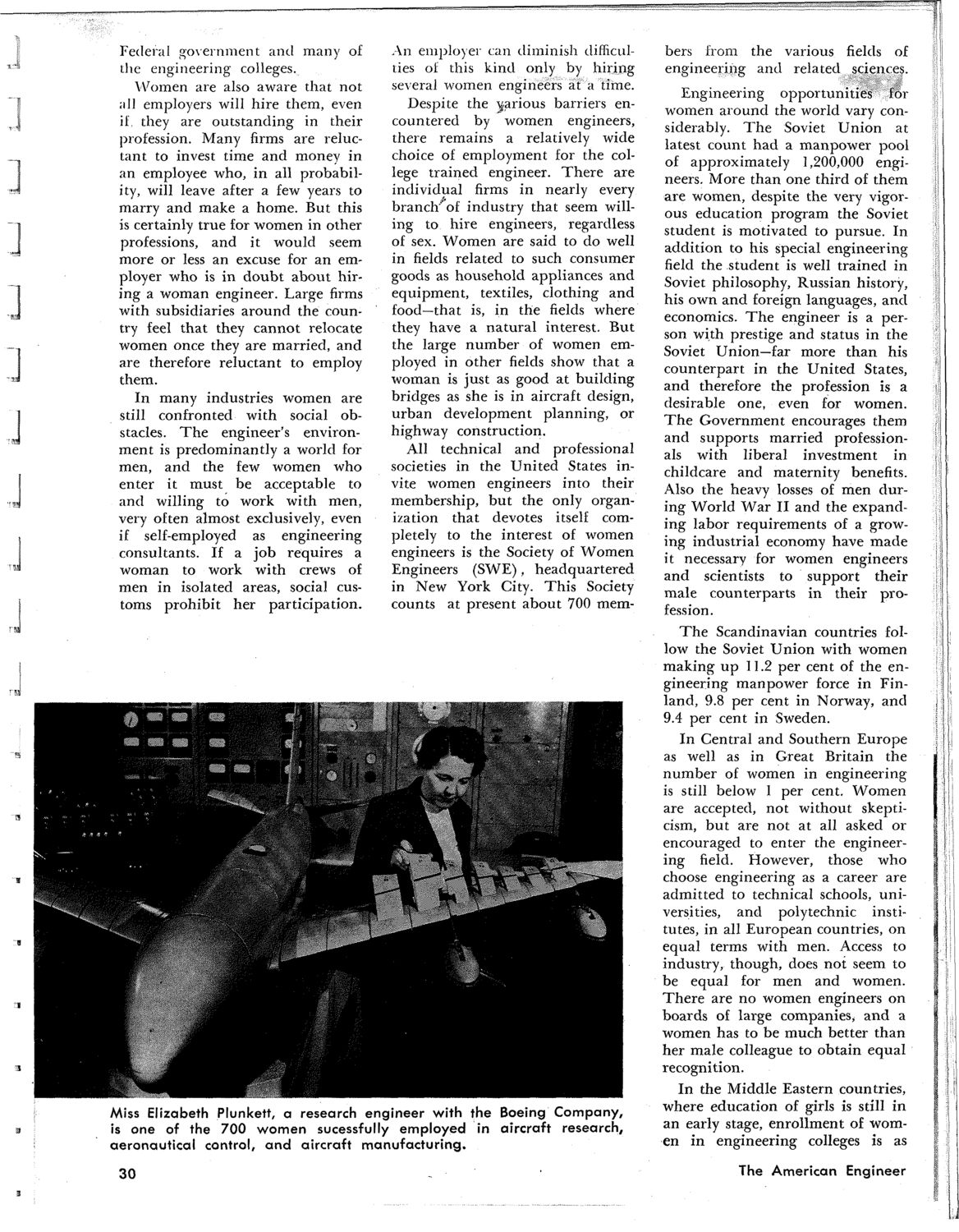| |
| |
Caption: SWE - News Clippings Book
This is a reduced-resolution page image for fast online browsing.

EXTRACTED TEXT FROM PAGE:
Federal government and many of the engineering colleges. Women are also aware that not all employers will hire them, even if, they are outstanding in their profession. Many firms are reluctant to invest time and money in an employee who, in all probability, will leave after a few years to marry and make a home. But this is certainly true for women in other professions, and it would seem more or less an excuse for an employer who is in doubt about hiring a woman engineer. Large firms with subsidiaries around the country feel that they cannot relocate women once they are married, and are therefore reluctant to employ them. In many industries women are still confronted with social obstacles. T h e engineer's environment is predominantly a world for men, and the few women who enter it must be acceptable to and willing to work with men, very often almost exclusively, even if self-employed as engineering consultants. If a job requires a woman to work with crews of men in isolated areas, social customs prohibit her participation. An employer can diminish difficulties of this kind only by hiring several women engineers at a time. Despite the various barriers encountered by women engineers, there remains a relatively wide choice of employment for the college trained engineer. There are individual firms in nearly every branch' of industry that seem willing to hire engineers, regardless of sex. Women are said to do well in fields related to such consumer goods as household appliances and equipment, textiles, clothing and food—that is, in the fields where they have a natural interest. But the large number of women employed in other fields show that a woman is just as good at building bridges as she is in aircraft design, urban development planning, or highway construction. All technical and professional societies in the United States invite women engineers into their membership, but the only organization that devotes itself completely to the interest of women engineers is the Society of Women Engineers (SWE), headquartered in New York City. This Society counts at present about 700 mem- bers from the various fields of engineering and related sciences. Engineering opportunities for women around the world vary considerably. The Soviet Union at latest count had a manpower pool of approximately 1,200,000 engineers. More than one third of them are women, despite the very vigorous education program the Soviet student is motivated to pursue. In addition to his special engineering field the student is well trained in Soviet philosophy, Russian history, his own and foreign languages, and economics. The engineer is a person with prestige and status in the Soviet Union—far more than his counterpart in the United States, and therefore the profession is a desirable one, even for women. The Government encourages them and supports married professionals with liberal investment in childcare and maternity benefits. Also the heavy losses of men during World War II and the expanding labor requirements of a growing industrial economy have made it necessary for women engineers and scientists to support their male counterparts in their profession. The Scandinavian countries follow the Soviet Union with women making up 11.2 per cent of the engineering manpower force in Finland, 9.8 per cent in Norway, and 9.4 per cent in Sweden. In Central and Southern Europe as well as in Great Britain the number of women in engineering is still below 1 per cent. Women are accepted, not without skepticism, but are not at all asked or encouraged to enter the engineering field. However, those who choose engineering as a career are admitted to technical schools, universities, and polytechnic institutes, in all European countries, on equal terms with men. Access to industry, though, does not seem to be equal for men and women. There are no women engineers on boards of large companies, and a women has to be much better than her male colleague to obtain equal recognition. Miss Elizabeth Plunkett, a research engineer with the Boeing Company, is one of the 700 women sucessfully employed in aircraft research, aeronautical control, and aircraft manufacturing. 30 In the Middle Eastern countries, where education of girls is still in an early stage, enrollment of women in engineering colleges is as The American Engineer
| |